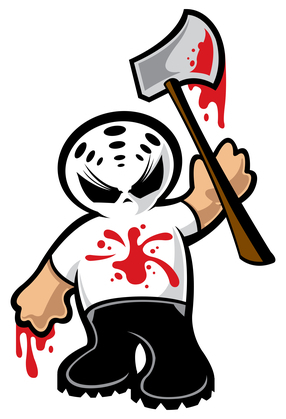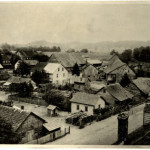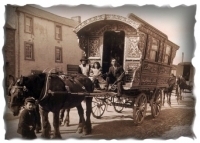Eleanor Sullivan's Blog, page 3
April 23, 2014
Step 6: Build a Story Structure
 Just like a building, a story needs a structure to frame your story. Wanting to make my work as easy as possible (remember I told you that you’d learn 10 easy steps to mystery writing), I use a simple 3-act structure.
Just like a building, a story needs a structure to frame your story. Wanting to make my work as easy as possible (remember I told you that you’d learn 10 easy steps to mystery writing), I use a simple 3-act structure.
Act I
In Act I you set up your story. Act I:
Introduces major characters, especially sleuth, victim, and killer
Presents key elements of the story world (time, weather, locale, and brief setting details)
Reveals inciting incident (the one that changes your sleuth’s world)
Act I ends with a major plot point (finding the body if it didn’t appear earlier or the arrest of a key suspect) and forces your sleuth to investigate.
Act II
This is the meat of your story. The sleuth gets busy trying to discover who killed your victim. Sadly, she’s faced with multiple obstructions. Of course, the villain tries to deter her, maybe even tries to kill her.
Remember all those characters you created? The sidekick, the mentor, antagonists, and suspects. They’ll all get in her way. Some of their problems have nothing to do with the murder; others will.
Now also is time to complicate your sleuth’s life with subplots. Is she at odds with her husband? Does her daughter disobey her? Is she having problems at work? Subplots can be minor (her boss is fired) or major (her husband wants a divorce). All of the subplots, though, must be resolved by the end of the story, at the end of Act II, if possible.
Midpoint in Act II comes another plot point, a major reversal in the story. Let’s say she’s certain she’s tracked down the killer. Every clue points to him. Then he’s killed. Her theory is destroyed.
She does what every winning sleuth does. She picks herself up, dusts herself off, and gets back on the trail. Now the killer does everything he can to stop her, throwing obstacle after obstacle in her way. In the meantime, other problems heat up as well. She’s served with a divorce petition. Her daughter runs away. Just like Dorothy in the Wizard of Oz, she keeps on keeping on.
Until the end of Act II. Plot point three and all goes wrong. A suspect is arrested but she knows he didn’t do it. Helpless, discouraged, all is lost.
Act III
No. She won’t stop. No matter what, she’ll find the real killer and bring him to justice. Now she brings all her talents to bear, all the skills she’s honed solving minor problems she uses to solve the murder. Risking life and limb, she tracks him, fights off his efforts to kill her until he’s caught. Or dead.
Denouement
You thought you could relax now, didn’t you? Sorry. You must tie up any loose ends in the plot and subplots. Explain how you deduced the killer, how you cornered him, how you revealed him. But do this quickly. Readers don’t want to hang around long once the killer’s caught.
How long should your story be?
My mysteries are about 300 pages long. What, you ask, do I fill all those pages with? Scenes! That’s next week’s post.
April 16, 2014
Step 5: Create a Killer and Suspects
As promised, this week we’ll create a killer and suspects to keep your sleuth confused. Confusion and complications–the hallmarks of good mysteries!
The Killer
The killer must have the means to kill, the motive to kill, and the opportunity to do the dastardly deed. MOM in mystery writer parlance. I start with the motive, which is suggested from the ideas about the victim from last week’s post. But there are many more reasons one might decide to kill. I’ve had killers who feared the victim would report him to the authorities, another who wanted to save the man she loved from certain hanging, and one who made a mistake, killing the wrong sister.
 The killer needs to be more fully drawn than other characters so as not to appear too obvious. The way to do that is to give him some positive characteristics, making him a more rounded person. I’ve given killers backstories that explain their anger, reveal their beliefs, and show why they fear abandonment. (You’ll learn how to use backstory in a future post.)
The killer needs to be more fully drawn than other characters so as not to appear too obvious. The way to do that is to give him some positive characteristics, making him a more rounded person. I’ve given killers backstories that explain their anger, reveal their beliefs, and show why they fear abandonment. (You’ll learn how to use backstory in a future post.)
Now, decide how he’ll kill and where. He needs a means he can manage. Can he get a gun and then get rid of it? What if he uses a knife/axe/hatchet? How will he get rid of his bloody clothing? Can he overcome the victim so he can smother or strangle him? How about poison? I’ve used succinylcholine (in a mystery, in case anyone thinks I murdered someone in real life). It met all my criteria for poison: it worked immediately and dissipated rapidly so would be unlikely to be discovered even if the person’s blood was tested. Even easier to poison in my historical mysteries because forensics hadn’t been discovered in 1833. I do have to watch for telltale signs and symptoms, though.
To inspire you to feel how a killer feels, think of a time when you were furious with someone. He cheated you out of money or recognition, attacked your child, or cut you off in traffic. You might slam around, beat your fists on your desk, or lay on your horn, but all the time you’d be thinking, “I could kill him!” Got it? The difference between you and your fictitious killer is that you can make him do it! (I’ve often had certain people in mind when I pick a victim.)
Suspects
To keep the killer from being too obvious, you must create suspects. Suspects each need to have a reason to kill the victim, the ability to do so, and be the same place and at the same time as the victim. A tall order and one I’ve struggled with repeatedly.
After you’ve planted suspects throughout your story, your sleuth must rule each one out as the murderer until the only person left who could have done it is the killer. There are several ways to rule them out.
Did he have a motive? Was it reason enough to cause him to kill?
Where was she at the time of the murder? (You can make that more difficult–another word mystery writers love–by obfuscating the time or place of the murder.)
Was her alibi witness reliable? Maybe he recants and admits she wasn’t home at the time. Or an alibi witness comes forward later in the story.
Was she strong enough to string him up to hang? Or to strangle him?
Keep asking these questions until you can exclude every suspect. Voilà! You have a killer!
What’s next week? Come back and see then!
April 9, 2014
Step 4: Create More Characters
 Last week we created our sleuth. This week we’ll create characters to surround the sleuth. These include sidekicks, mentors, antagonists other than the villain, the victim, the killer, and suspects. You can use some of the same characteristics you learned in creating your sleuth but to a lesser degree depending on the needs of the story.
Last week we created our sleuth. This week we’ll create characters to surround the sleuth. These include sidekicks, mentors, antagonists other than the villain, the victim, the killer, and suspects. You can use some of the same characteristics you learned in creating your sleuth but to a lesser degree depending on the needs of the story.
Sidekicks and Mentors
You’ve learned that your sleuth must be a well-rounded person with both talents and faults. Sidekicks and mentors help round her out a bit more. A sidekick might be a cop, either one she works with if she’s an officer, or a friend who helps her. Monika (Monika Everhardt Medical Mysteries) has BJ, a girlfriend from childhood, who tells her how the justice system works but mostly tries to keep her from investigating murders! A sidekick could also be a friend who has some other specialized knowledge, such as computer tech able to find discreet online info.
Mentors help your sleuth in all kinds of ways. Adelaide (Singular Village Mystery sleuth) has Emma, her surrogate parent who taught her midwifery and herbal medicine. Mostly, though, she is a thoughtful, intelligent woman who, despite being blind and disabled, continues to ponder Adelaide’s dilemmas, offering valuable advice.
Also, when your sleuth interacts with a sidekick or a mentor (as well as other characters), she reveals details about herself. In the same way, when they question, disagree, or challenge her, we see more of her character. And the more we get to know her, the more we want to know. That’s what keeps readers coming back!
Antagonists
In addition to a killer, other characters must cause the sleuth problems–just like in real life. Maybe she’s about to lose her job because she’s spent so much time trying to track a killer and if she does, she might be evicted from her apartment. Maybe her father is demanding her help, her son is in trouble in school, or her boyfriend wants more of her time. The people and the problems you can give her are endless. And they are ways to build subplots (in a future post). Just be sure you don’t give her so many antagonists that she doesn’t have time to solve the murder.
The Victim
You learned some things about the victim in Step 1: Start with Murder. You know he may be evil or a saint. But the one characteristic all victims have in common is that the killer wanted them dead. Why? The threat might be real or imagined but the killer beliefs it’s so. Maybe he hurt the killer or his family in some way or maybe he’d done no harm. The killer might think he could do him wrong. Maybe he thinks the victim might steal his wife or his money. Or he might be selling his son drugs. One woman took a bat to a drug dealer for that reason. (I can’t make this stuff up.) Nonetheless, he has to die.
Yikes! I’ve done it again! Written too much and now must delay telling you how to create killers and suspects. Coming next week, I promise.
April 2, 2014
Step 3: Create Characters
 Now that we’ve discovered a murder and built a story world, it’s time to create our characters. Where to start? You might think we should start with the victim…but you’d be wrong. Think of it this way: who is in every story, especially if you’re writing a series? The sleuth! She might discover any number of victims and reveal numerous killers, but only she will star in every story.
Now that we’ve discovered a murder and built a story world, it’s time to create our characters. Where to start? You might think we should start with the victim…but you’d be wrong. Think of it this way: who is in every story, especially if you’re writing a series? The sleuth! She might discover any number of victims and reveal numerous killers, but only she will star in every story.
Your Sleuth
Again, you might think you should start with a physical description…but you’d be wrong. Think about it. What characteristics does your sleuth need to unravel a murder? She must be willing and able to pursue a killer, overcoming all the complications that others can throw at her to keep from succeeding. A tall order. Who among us would be willing to track down a killer? Your sleuth is!
Characterizing your Sleuth
She needs to carry the entire story so beyond her skills of detection, she also needs a life. To get to know your sleuth, answer these questions:
What does she value most in the world?
Money
Fame
Family
Reputation
Appearance
What does she fear most in the world?
Loss of what she values most
Abandonment
Sickness
Flying
Dying
What is her secret fault?
Guilt
Shame
Pride
Vanity
Greed
Discovering her strengths and weaknesses
You can see she needs both strengths and weaknesses and these can be categorized as external and internal.
What external strengths does she have?
Black belt in Tae Kwon Do? (useful when she confronts a larger than life killer)
Super intelligent (member of Mensa)
Able to solve puzzles (works the Saturday NYTimes crossword)
What are her internal strengths?
Passion for justice (her motto: right is right)
Can’t stand anyone done wrong (won’t let an innocent man be hanged)
Determined to succeed (won’t let obstacles deter her)
What are her external weaknesses?
Struggling financially (single mother)
Overbearing boss or spouse (interferes with investigation)
Starting new business, class, profession (time consuming)
What are her internal weaknesses?
Grew up poor and fears poverty (will work herself to death if need be)
Caused someone’s death and fears she might again (Adelaide’s weakness in Singular Village Mysteries)
Family killed and fears for own children (Benjamin’s weakness in Singular Village Mysteries)
Have you answered these questions? If you have, you’ve created a rounded person with faults and frailties as well as serviceable powers. One more characteristic is needed: She must be active! She can’t let events happen to her but, if they do, she must act to change the situation. She must take an active role and be resourceful in solving problems, including murders.
Finally, you can give her a name and description. Use her name to reveal her personality. Monika Everhardt stars in my nurse-centered mysteries. Adelaide is a midwife in my Singular Village Mysteries but Gerda works as the evil matron of the girls’ dormitory.
Even your sleuth’s description should make her distinctive. Not a blue-eyed blond but a frizzy-haired, smart-talking woman. She could be tall (indicates strength) but awkward (a weakness). Or short (my fav) but muscular. The list goes on…
Well, sadly, I’ve overwritten this post about creating characters and now I’m out of space to help you create your other characters. So, you’ll need to wait until next week to learn how to create sidekicks, mentors, antagonists, killers, and victims.
March 26, 2014
Step 2: Build a Story World

Courtesy of Ohio Historical Society
Building a story world is great fun. I get to explore places and people I might never have met either in history or in person.
I start with the big picture environment. Is the setting a real place? Is it contemporary or historical? Can I travel there? Or create it from my desk?
How much can I actually see? For my contemporary medical mysteries, the story world was an intensive care unit in an urban hospital. I’d seen many of those units but no way would a hospital allow me access, especially since a murder would soon occur there.
For my current series, the Singular Village Mysteries, I travel often to Zoar, Ohio to explore the town, talk to residents, study in their research library, and interview the historian. Why isn’t that perfect for me? Because the stories are set in 1833! Creating that world requires additional research into how people lived and worked in that era.
Is the story world limited to one location? Probably not. To get my characters in trouble, they must move around or be dragged about. What is that setting(s) like? It may differ considerably from the cozy cabin where my character lives. She might be thrown into the hustle and bustle of a crowded city on market day, overwhelmed by the stench of horse droppings and sewage. Or she might be thrilled to experience the sights and sounds of the busy city streets, crowded with vendors hurrying about to deliver numerous goods to potential buyers. Or her mood might change depending on events in the story.
Once the big picture environment is created, details must be added. These include:
What are the cultural, religious, and political beliefs of the people?
Are they well-to-do or perpetually hungry? Or from both sides of the tracks?
What work do they do? Is it satisfying or dull?
Do they live in houses, apartment buildings, mansions, or tenements?
Many more details will be added as the story begins to take shape.
Next I drill down to the specific dates of the story. How many hours, days, weeks, or months pass during the story? What events transpire in the normal story world? In Tree of Heaven, that I’m creating right now, it’s September, the harvest is in and the apples (a major crop) are ripe. Time to make apple butter. What complications can I build into that project? These may have nothing to do with the murder. Or they may.
Okay, I have my time and place. Let’s populate it with people. That’s next week’s step.
March 20, 2014
Step 1: Start with Murder
 In beginning a new mystery, I start with the murder.
In beginning a new mystery, I start with the murder.
Who’s the victim?
Who’s the murderer?
What’s his motive?
How is she killed?
Where is he killed?
The victim might be not so nice, regardless of appearances. He may have a dark or devious side to his personality. Maybe he cheated the killer out of money or his wife. Threatens his livelihood or his life. Or the life of a loved one. Conversely, he may be a good guy who saw a crime occur. He must die to save the killer from prison, for example.
Motives include.
Revenge
Money
Lust/Love
Save oneself or loved one
Or many other reasons, actual and imaginary
I’ve had a villain who killed to save someone from going to hell. (yeah, I know, I don’t understand these characters sometimes either.) Another wanted the victim’s inheritance. One desired his wife.
Now let’s find a way to kill. Methods include:
Poison (very useful in my historical mysteries)
Firearm (common today but less so in bygone eras)
Knife/axe/hatchet (messy but works)
Smother/strangle (without forensics could obscure cause of death)
Drowning (the killer’s wet clothes might be a giveaway)
Hanging (another not so messy method)
Or the proverbial blunt object (can’t always count on it to do the job)
Next we must find a place for the murder. It must be out of the way, a place where the killer and victim won’t be disturbed, and where the killer can get away without being seen. Umm. A tall order.
I’ve had murders occur in a busy hospital intensive care unit unbeknownst to staff scurrying about, in a deserted barn with only horses to witness the crime, in a cemetery, a river, a wheat field, and more. Get the victim alone, overcome him some way, and strike. Not for the faint of heart.
Okay, now I have a killer, a victim, a motive, a method, and a place.
Time to build a story world around them. That comes next week.
March 12, 2014
How to Write a Mystery in 10 (easy?) Steps
 I promised my blog readers that I’d only post about 19th century lore but…recurring questions at book events about how I craft a mystery have spurred me to deviate from my plan. So, to please anyone who wants to know how I craft my stories, the next 10 weeks-one step each week-will tell you.
I promised my blog readers that I’d only post about 19th century lore but…recurring questions at book events about how I craft a mystery have spurred me to deviate from my plan. So, to please anyone who wants to know how I craft my stories, the next 10 weeks-one step each week-will tell you.
And, the time is right. I’m just beginning the third book in my Singular Village Mystery series, and I plan to match the week’s process with a post on how I do it, reporting in real time.
For example, the first week I’ll post about how I start with the murder, the next week how I build a story world around it, the third week I’ll be creating characters, and so on. Feel free to comment on any of the posts. I’d especially like to hear from other writers about how their strategy varies from mine. And readers’ suggestions are most welcome. Your idea might make it into the story.
Today, though, I’ll give you an overall view of my books. Just as I must position my characters in a specific place and time, the reader, too, needs to know where she is.
To start, I only write mysteries in a series because that’s what I like to read. If you’re a budding writer, here’s your takeaway: write what you read. You’ll spend hours, weeks, maybe years crafting a story. That’s difficult enough, but to do it with content you don’t absolutely love? Well, that’s just needless suffering.
The Singular Village Mysteries are my second mystery series (more about the earlier series in a future post). The stories are set in the 1830s village of Zoar, Ohio where my ancestors found sanctuary after escaping from religious persecution in their native Germany. To survive, they became communal and for a time, practiced celibacy (presumably!) to free the women from childbearing to work alongside the men. In addition to cooking, cleaning, washing and more, of course.
In this series we are privy to the two main characters’ viewpoints: Adelaide, a young midwife, and her husband, Benjamin, the local cabinet maker. Secondary characters include Adelaide’s sister, Nellie, traumatized by years in the girls’ dormitory under the cruel charge of the matron, Gerda, and various friends, supporters, and enemies among the villagers.
Because my distant grandfather, Joseph, was the leader of the town, he necessarily plays a role in stories that consistently offer up a new corpse. And a new murder!
Fortunately for me, historic records reveal that, although he led the villagers to prosperity, he also was a domineering man who kept control over the money, the lands, and the people. Here’s an historic tidbit about him: Although everyone had contributed to the town’s success, pooling their resources and working communally, Joseph didn’t sign the property (more than 10,000 acres) over to the town until he was on his deathbed. A fortuitous foil for Adelaide.
Okay, now you know where you are. Come back next week for the murder!
July 9, 2013
Irish Travellers Invade Zoar, Ohio: Fact or Fiction?
 Much is believed to be known about Irish Travellers. And some of it is true!
Much is believed to be known about Irish Travellers. And some of it is true!
Origins
Often confused with Romany Gypsies whose origins began in northern India, Irish Travellers originated in Ireland more than 1,000 years ago, separating from their settled brethen to establish distinct communities, language, and mores. (For verisimilitude, I’ve used the Irish spelling of Traveller and capitalized it accordingly.) Confirmed nomads, Travellers shunned a permanent home, clustering instead in kinship groups of canvas-covered wagons ladened with all their worldly goods. Emigrating to the United States in the early 19th century, they traveled throughout the northeast, later moving south. The men, known for their skills as tinkers, mended tinware, such as pots, kettles, and pans, while the women peddled small items, such as combs, beads, laces or paper flowers.
Language and Religion
Travellers have their own language, dialects of Shelta, also known as Cant, which serves to obscure their meaning from outsiders (especially helpful when they’re planning to dupe someone!). A greeting, for example, might be “Grālt’a” or “Slum hawrum” (Hello or Good morning in English).
Although some Travellers continue to practice Roman Catholicism, many eschew traditional religion, believing in the power of the “little people” and other pagan traditions. Travellers have a distinct moral code, however, especially allegiance to the family, girls’ chastity before marriage (men, of course, pride themselves on female conquests!), and a belief that “settled folk” were designed to be fooled. Child marriages, even to first cousins, helped maintain women’s purity and ensured no outsiders’ blood tainted the community.
Education and Work
Outside education is shunned; children are prepared for their roles in the community, distinct and separate work for women and men. Women are charged with maintaining the home, be it only a cluttered wagon, caring for children, and collecting or making small items to sell. Men interact with the outside world, originally repairing tinwork but, when the production of mass-produced goods made that work obsolete, they practice their age-old skills of tricking outsiders. Remember, settled people were meant to be duped! Rightfully viewed with suspicion, Travellers often abscond with residents’ belongings and leave town without completing paid-for-work.
So, did Irish Travellers invade Zoar, Ohio? No historical records document any such event. But…they might have!
Want to meet some Irish Travellers?
Meet a man named Egan, and his band of motley children, in Graven Images, the second Singular Village Mystery, available September 1st! Can’t wait? Read an excerpt here: Graven Images excerpt
February 28, 2013
Roots, Shoots, and Leaves: Early Medicine’s Herbs
Ever wonder what people used to cure old-fashioned ills? Before pencillin?
And they’re still being used in health care today.
Recently, I had the opportunity to meet a practicing herbalist in Minneapolis, a young woman with a quick smile and quicker wit. Lise Wolff opened my eyes to a different health care world. (For those who don’t know, I’m a nurse turned author.)
From pre-historic times to today, herbal remedies have been used to treat human ills. Often they were the only treatments available. Our existence is testament to their effectiveness. Scoffed at by medical men (yes, they were all men), herbalists and their close cousins, homeopaths, nevertheless persisted. What was known as mainstream medicine at that time, however, would be unrecognizable by today’s practitioners. Purging, puking, and bleeding as well as dosing with heavy metals, such as mercury, harmed more often than cured, their unwary patients. (See Medical Care in the 19th Century-Part One and Part Two for more on this era’s archaic practices.)
Herbal Remedies
Herbs can be collected in the wild or cultivated in gardens. Most remedies are derived from the leaves that are harvested at the peak of their effectiveness, but sometimes the stems, roots, or early shoots prove more useful. Leaves may be dried and used in teas or combined with starch or lard for poultices. Plant parts may be soaked in water or oil, and the solutions used in tinctures, decoctions, essential oils, salves, or ointments. I watched Lise melt beeswax and combine it with St. John’s wort solution that she poured into metal cups, left to solidify and use as an ointment to treat burns, sores, and cracked lips.

Lise’s Herbal Solutions
The Separatists of Zoar collected herbs in the wild as well as maintained a herb garden for both food and medicine. The herb garden can be seen today planted in front of the greenhouse and laid out exactly as it had been by the early settlers.
In the 19th century women, often midwives, treated ill family members and neighbors with herbs, a practice passed down through generations. Realism meets fiction as Adelaide, protagonist in my singular village mysteries, works as both a midwife and herbalist in 1830s Zoar.
Doctrine of Signatures
After famously burning classic medical texts, 16th century German physician Paracelsus declared that plants resembling human body parts could cure ails in that organ, a concept that became known as the doctrine of signatures. Thus, “like treats like.” Lise’s St. John’s wort doelike shape renders it perfect for treating skin wounds.
Homeopathy
Similarly, Samuel Hahneman, a 19th century German physician, agreed that like treated like but took treatments one step further, diluting substances over and over until it appeared that nothing of the original substance remained. These dilute substances, however, proved remarkably effective. The practice became known as homeopathy.
The Separatists of Zoar also practiced homeopathy. In fact, Joseph Bimeler, their leader, was a known as a homeopathic physician. (Whenever did this man find the time to manage–some say micromanage–the community, preach on sundays, and practice medicine?). A medicine box of homeopathic remedies can be found in Zoar’s historic artifacts and a picture of it is in my photo album.
The medical community today would argue that neither herbal remedies nor homeopathy are scientifically proven to be effective. Regardless, patients dissatisfied with mainstream medicine, often turn to alternative practitioners, such as herbalists. Medical practice is continually evolving as new remedies and treatments emerge and others decline. Might chemotherapy be deemed archaic 200 years from now?
Watch as Adelaide confronts problem illnesses and birthings in the next Singular Village Mystery: Graven Images, due September 1st!
December 7, 2012
Tracking the Separatists in Germany: Last Stop: Prison, Penitentiary, and Punishment
Continuing the saga of the German Separatists, our small group of Americans traveled deeper into the German countryside to explore the darker side of the Separatists’ experiences. And their bravery.
As Wuerrttemberg historian Dr. Eberhard Fritz explains, the Separatists ignored increasing threats from authorities to return to church or suffer the consequences. On Christmas Day 1803, eleven Separatist men were arrested. One frail young man was left behind but his father promised to thrash him for his disobedience. The men were sentenced to prison.
Prison
Somberly, we climbed the hill to the prison, called Hofenasperg Fortress that sits high above the town of Asperg. Inside, we found a small museum with a guide who explained the exhibit about the Separatists’ imprisonment. Future Zoar settler, Stephan Huber, was imprisoned and interrogated (try not to imagine such interrogation) there for six months in 1805.

Hofenasperg Fortress
Later, he inspired Joseph Bimeler to become a Separatist, setting the stage for their emigration to America in 1817. Huber’s descendant, Deborah Deal, was a member of our group and had known little about her brave ancestor. Perhaps fortutiously, we couldn’t see the actual cells because the building is still used as a prison, albeit a prison hospital. We were kept well away from the inhabitants–inmates and guards alike.
Penitentiary
Women were incarcerated in the Ludwigsburg Penitentiary and, although we didn’t visit it (now a justice administration and archive building), we do know a few details about the Separatist women incarcerated there. Their crimes: Insulting the authorities or refusing to send their children to the state (religious) schools. Sentences at both the prison and the penitentiary varied from a few weeks to years. In 1817 both men at the prison and women at the penitentiary were offered release if they agreed to emigrate. Three men and two women refused; the rest were released.
Punishment
Beatings, lashings, canings, and the pillory (Stephan Huber experienced all those) were common punishments in addition to confinement to windowless cells and scant sustenance. Although such punishments were common for criminals, the Separatists’ only sins were refusing to follow the state religion and refusing military service in the interest of the state. Believing that all men and women were created equal, they saw no reason to value state authorities, including kings, above anyone else. For such beliefs, they suffered.
But a unique punishment awaited the Separatists. Because the Duke of Wurrttemberg desired a lake in front of his castle, he ordered prisoners to dig it. The royals, however, didn’t want to see the mess such digging would create, so he ordered the digging be done at night! This sounds cruel but not as ruthless as we discovered when we saw the lake and, for myself, a long walk around it.

Lake dug by the Separatist…at night!
Finally, records show that two Separatists died as a result of their beatings.
Conclusion
What can we conclude about our famous forebearers? That they were courageous beyond our imaginations; their integrity, shown by standing for their beliefs despite loss of freedom, fortune, or life, exceeds anything we could envision.
This concludes my reports of our momemtous trip to our ancestors’ homeland. Special thanks to Marilyn Gordon for her meticulous notetaking and to our two historians, Dr. Eberhard Fritz and Dr. Hermann Ehmer, for detailed information and for freely answering our many questions.
But don’t worry. I’ll be back with another report on these unique people. Look for “Sex and the Separatists” next time!




